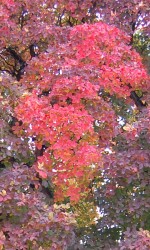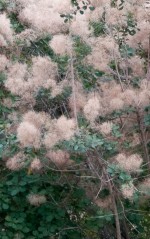 American smoke tree is a deciduous large shrub or small tree native to Oklahoma, Texas, Arkansas, Missouri, Alabama, and Tennessee where it grows in woodland edges, clearings, glades, and rock outcroppings. It is very rare in the wild and may be facing extinction there but is grown in botanical gardens throughout the world. A member of the cashew family, Anacardiaceae, that also includes sumac, mango, and poison ivy, it features beautifully twisted branches and bluish-green, five inch long, paddle-like leaves that turn orange to red in autumn. In summer long hairs surrounding the large panicles of inconspicuous flowers form pink to purplish pink plumes that create a smoky haze giving rise to the common name. American smoke tree can be used as a unique specimen, or can be cut down to the ground each year and used in a mixed border or as a hedge. An excellent choice for urban conditions. The generic name, Cotinus comes from the Greek word kotinos meaning wild olive, The specific epithet obovatus comes from the Latin word meaning in the shape of an inverted egg.and refers to the leaves.
American smoke tree is a deciduous large shrub or small tree native to Oklahoma, Texas, Arkansas, Missouri, Alabama, and Tennessee where it grows in woodland edges, clearings, glades, and rock outcroppings. It is very rare in the wild and may be facing extinction there but is grown in botanical gardens throughout the world. A member of the cashew family, Anacardiaceae, that also includes sumac, mango, and poison ivy, it features beautifully twisted branches and bluish-green, five inch long, paddle-like leaves that turn orange to red in autumn. In summer long hairs surrounding the large panicles of inconspicuous flowers form pink to purplish pink plumes that create a smoky haze giving rise to the common name. American smoke tree can be used as a unique specimen, or can be cut down to the ground each year and used in a mixed border or as a hedge. An excellent choice for urban conditions. The generic name, Cotinus comes from the Greek word kotinos meaning wild olive, The specific epithet obovatus comes from the Latin word meaning in the shape of an inverted egg.and refers to the leaves.
 Type: Deciduous large shrub or small tree
Type: Deciduous large shrub or small tree
Outstanding Feature: Fall coloration; bloom in summer
Form: Oval to rounded; irregular
Growth Rate: Rapid when young
Bloom: Long hairs surrounding the panicles of inconspicuous flowers form pink to purplish pink plumes that create a smoky haze all over the tree in summer.
Size: 10-30’ H x 10-20’ W
Light: Full sun to light shade
Soil: Average to lean, moderately moist, well-drained; tolerates some drought.
Hardiness: Zones 4-8
Care: Needs pruning to develop good structure. Cut to the ground in late winter to maintain shrub-like habit and improve overall appearance.
Pests and Diseases: None of significance but susceptible to wilt, leaf spot, and rust.
Propagation: Cuttings, layering, seed (difficult); transplants well.
Outstanding Selection: ‘Red Leaf’’ (best fall color)